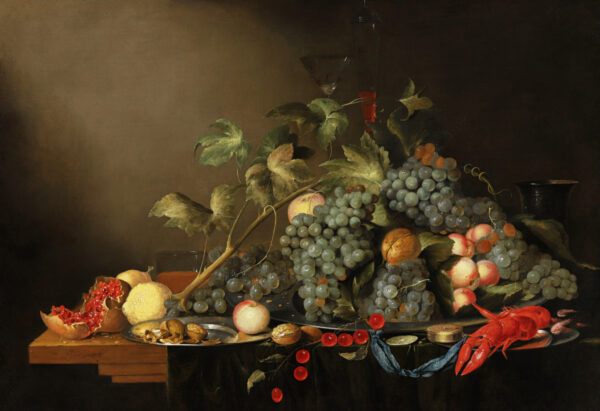“Still life fruits, nuts, peaches and a lobster on a table”
Oil on canvas: 81 x 131 cm; framed: 105 x 155 cm.
with original signature: ‘J.D. Heem f.’ and circa 1643
"*" indicates required fields
Notes
As described by Fred G. Meijer, this painting is one of two studio versions by a pupil of the original work by Jan Davidsz. de Heem which can be found in the collection of the Virginia Museum of Fine Arts (inv. No. 61-15). After inspection Mr. Meijer concluded that this work must have been made by a student in the studio of De Heem due to several stylistic relations to both the original work as well as the other version. Unfortunately it is not possible to identify the pupil of the Master for this artwork. It does bear the original signature of Jan Davidsz. De Heem as was common practice due to the guild rules at the time. A painting was only allowed to be sold if it bore the signature of the master of the studio as its approval. Often pupils would make high quality versions of the master’s work, who would in turn lend his hand to the painting and work out some important details before signing off on the artwork. This is probably the case in this painting.
This world famous Flemish/Dutch painter of sobre and yet often lavish still lifes grew up in Utrecht, where he was apprenticed to flower still life painter Balthasar van der Ast. In 1626 the painter moved to Leiden. There he made monochrome (“one-color”) still lifes, in which he varied on one, at most two, shades. His subjects were mainly musical instruments and books. After 1631 De Heem left for Antwerp. In this city his work became increasingly colorful and elegant. He also changed the subject and focused on depicting fruits and flowers. Although De Heem lived predominantly in Antwerp, he still regularly spent some time in the North. He was in Utrecht in 1649 and between 1665 and 1672. The work of Jan Davidsz. de Heem was popular with buyers as well as fellow artists. He also had a large number of students and followers, including Abraham Mignon. He was further influenced by Pieter Claesz in his banquet pieces.
De Heem was one of the greatest painters of still lifes in the Netherlands, combining a brilliance and harmony of colour along with an accurate rendering of objects: flowers, in all their variety; European and tropical fruits; lobsters and oysters; butterflies and moths; stone and metal; snails and sea shells.His still lifes included fruit pieces, vanitas still lifes and flower pieces, but he is best known for his ornate or sumptuous still lifes, the so-called ‘pronkstillevens’.
His remarkable talent gained him a considerable reputation. He could hardly satisfy the demand. De Heem was considered one of the greatest painters of his time. He was well paid and a portrait of Prince William III surrounded by a cartouche of flowers and fruit was sold for 2000 guilders, one of the highest prices ever paid for a painting during the Dutch Golden Age.
Provenance:
- Collection Lady Portarlington;
- Sale F. Muller & Co., Amsterdam 20/27 October 1942, lot 38, ill. As by J. Dz. De Heem;
- Private collection, The Netherlands, 2009;
- thence dy descent
Expertise
This painting is accompanied by a letter of Fred G. Meijer, March 28th 2022, attributing this work to the Antwerp studio of Jan Davidsz. de Heem.



